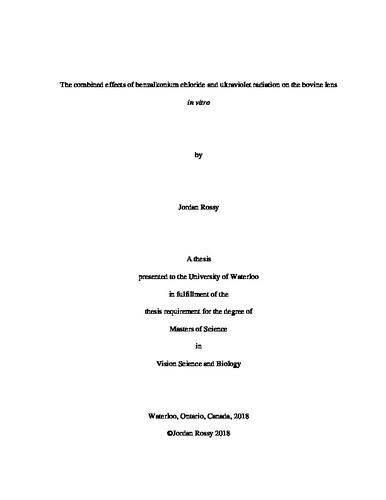| dc.description.abstract | Purpose: To determine the combined effects of benzalkonium chloride (BAK) and ultraviolet radiation (UV) using the primary culture of intact bovine lenses.
Methods: Abattoir-provided lenses were dissected from the eyes of cattle age 2 to 3 years. Lenses received one of three treatments: BAK, UV, or BAK followed by UV exposure. BAK-treated lenses received 10 minutes of exposure to a test solution prepared at 0.01%, 0.005%, or 0.001% concentration with PBS. Irradiated lenses were treated for 1.5h at a measured irradiance of 11.32411 W·m-2 (280-400 nm). Lenses receiving the combined treatment underwent the BAK treatment condition followed by UV irradiation. The effects were measured using the alamarBlue metabolic activity assay (n=8), and the ScanTox laser-scanning system to assess optical quality (n=6). PBS exposure served as the control treatment. Assessments of metabolic activity were performed on days 0, 2, and 7 following exposure. Optical quality was assessed on days 0, 2, 7, 14, 16, 18, and 20.
Results: BAK-induced toxicity was concentration-dependent. Treatment with BAK 0.01% and 0.005% resulted in reduced lens metabolic activity on day 2 and day 7, respectively (p<0.05). Optical quality was significantly reduced for 0.01% BAK-treated lenses on day 7 (p<0.05). For UV-treated lenses, reduced metabolic activity was observed on day 2, while optical quality was significantly diminished on day 14 (p<0.05). Combined treatment reduced lens metabolic activity and optical quality (p<0.05). Effects were demonstrated earlier with the increasing concentration of BAK. However, the combined effects of BAK and UV were not significantly different from BAK alone for metabolic activity, or from UV alone for optical quality (p>0.05).
iv
Conclusion: The combined effects of BAK and UV were not significantly different from the independent exposures. Reductions in metabolic activity were detected prior to changes in optical quality. | en |

